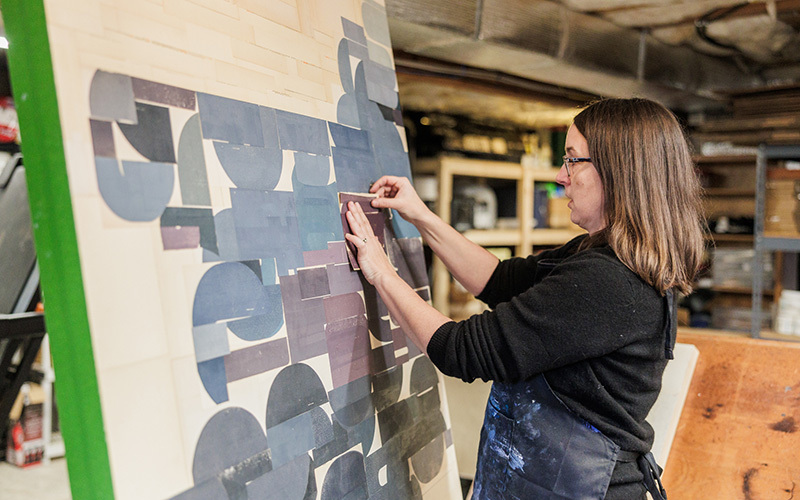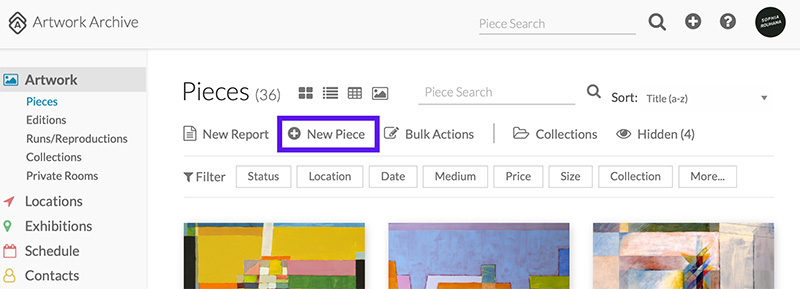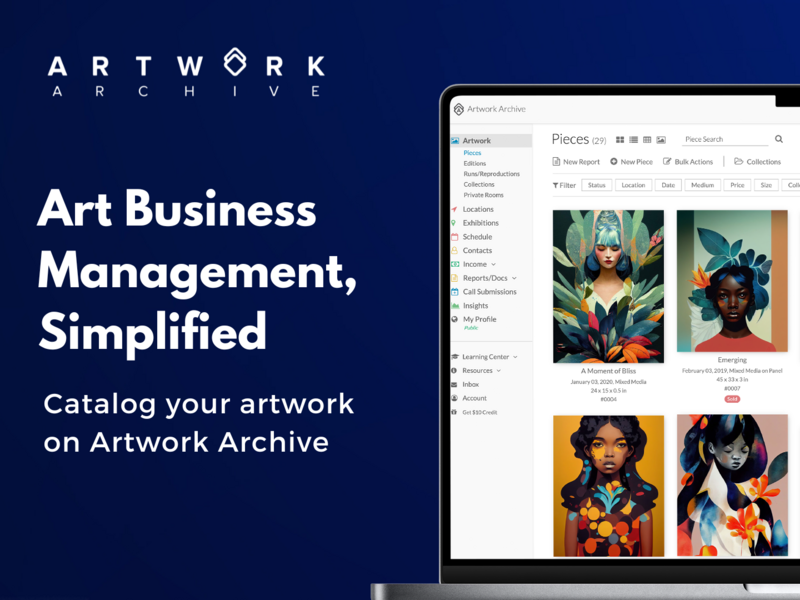For artist Sarah Short, a successful week involves plenty of well-planned time for creativity.
Contemporary collage artist Sarah Z. Short has a way with words. That’s not just because she used to be an English teacher, though that personal history plays out in the insightful essays she posts to her blog regularly.
Instead, letters and words quite literally make her entire practice possible: From the pages of old books she rescues to become the surfaces of her energetic collages, to the letterpress blocks she turns into abstract printmaking tools, to the evocative titles and descriptions she creates for her works, language suffuses this thoughtful artist’s work.
So when she sat down to walk us through a typical week in her life, she came prepared with words and insights into what it takes to sustain a creative life. Below, Sarah has described how she prioritizes her creativity, even when it’s not the most convenient. She tells us how she balances her family with a busy exhibiting, teaching, and artmaking schedule. And she tells us how she schedules administrative blocks into her week, to ensure that the business side of her practice continues to feed the creative side. “I won't have an art business unless I spend at least some time each week getting the administrative work done,” Sarah told us—and she also gave us some helpful tips on using Artwork Archive to make that administrative work easier.
In our "Making It Work" series, we take you through a week in the life of working artists' lives to show how they strike the right balance between creative passion and professional sustainability. Today, we follow collage artist Sarah Z. Short through her week as she navigates studio time, business management, and everything in between—showing how tools like Artwork Archive help transform administrative hurdles into stepping stones for artistic success.
The Artist: Sarah Z. Short
Age: 46
Location: Rhode Island
Medium: Collage
Income Sources: Private sales, workshops and teaching
Art Admin Tool of Choice: Artwork Archive
Studio Secret Weapons: Christmas lights and Nag Champa
Monday: Getting Back Into the Creative Groove
I don't remember how to make art! How do I even start a new piece?
Mondays are always hard, but last week was April school vacation. So now I'm back in the studio at 8:30 am, ready to work, yet it feels like I’ve never made a collage before.
My creative universe is split between two realms: my basement studio where art happens and the upstairs living spaces where business unfolds. My daily studio ritual begins with overhead lights flickering on, Christmas lights plugged in, a stick of Nag Champa incense lit, and Bluetooth speakers connected to my audiobook.
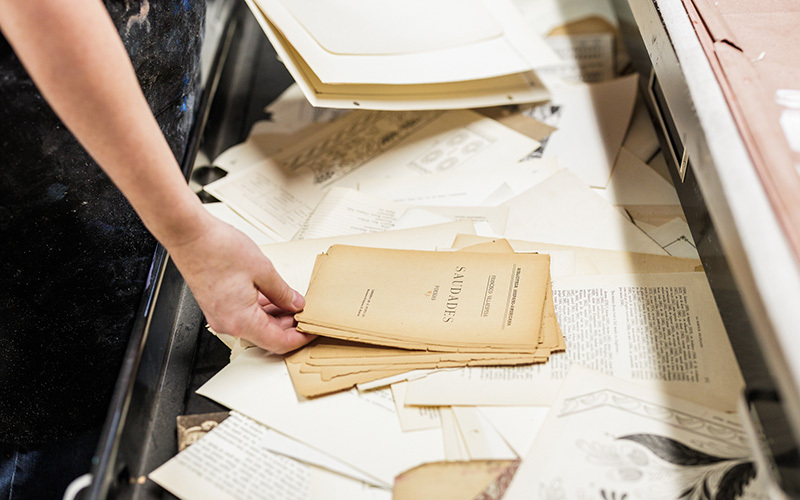 Sarah keeps an impressive collection of old books and papers to use as source material for her collages.
Sarah keeps an impressive collection of old books and papers to use as source material for her collages.
Next month I have a show in Colorado, which I’m excited about—but that means I have work to do. I have to complete a few pieces this week to meet the shipping cut-off. Many new pieces need to be photographed, recorded in Artwork Archive, varnished, framed, photographed again in situ, packed, and shipped. This week is the deadline I've set for myself to create the pieces, and I need a few more (plus others need to be revised).
All of which is to say, I don't have time to forget how to make a collage! Distractions are everywhere—hunger driving me upstairs for snacks (I dream of a mini-fridge for any future studio), cats demanding attention, family needs, the persistent allure of my phone with its social media tether. I wonder about artists who lose track of time for hours—are they myths? I've certainly never been one.
After an hour of getting nowhere (three pieces of paper glued down), I head upstairs for a snack and my second latte before I make things worse. Maybe tomorrow I’ll remember.
Tuesday: Studio Time Starts to Deliver Results
As I was building up my career as an artist, I learned how to create even in the spare time between my teaching job and family life. I carved out a corner of the living room for a table and art supplies, and launched my career. Those small collages led to sales, to confidence, to a career change, and a larger studio. But I still use any place I can to make sure I have time for my practice.
My coffee table becomes a photography studio for smaller pieces, capturing them in the room's superior natural light. The couch transforms into a place for reflection, notebook in hand, thinking through the "messy middles" of both art and writing projects. My car even becomes a satellite office during my son's soccer practices. All of this adds up, so that when I finally do have time to spend in my studio again, I make it count!
Back at the computer today, I scan a new 12x12 inch piece in sections and use Photoshop to merge the image. This cuts a bit off all four sides of the original, but not enough to impact the composition, and it leaves me with a high-quality image to email to the Colorado curators for approval.
Even if it seemed like my muddling yesterday didn’t move the needle much, just being in the studio made it possible for me to come in today and get to work.
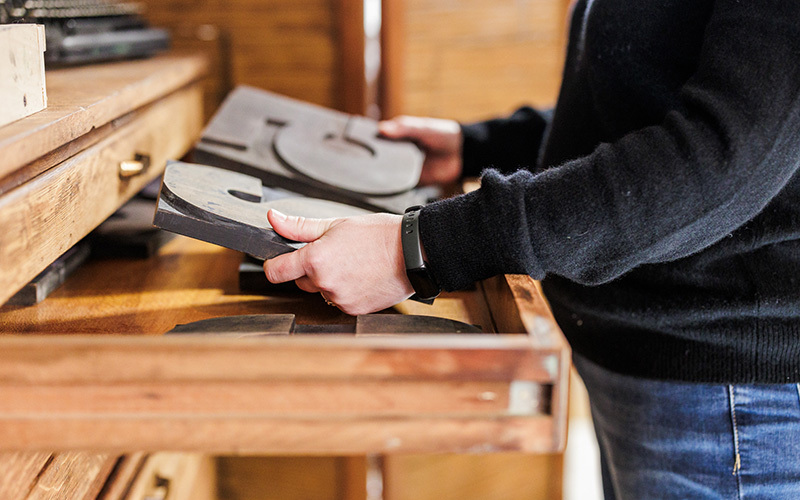 The large, wooden letterforms become evocative abstractions in Sarah's final works.
The large, wooden letterforms become evocative abstractions in Sarah's final works.
So now it’s time to update Artwork Archive with the new piece and licensing information, post to Instagram, answer more emails, and add more to my to-do list. There are contracts to print/sign/scan/email, comments to respond to on social media, and text messages with a gallery director. This is why I can't check my computer all the time: when a notification pops up, it's easy to feel like I have to jump into emails and get things done immediately. But by setting aside some admin time each day, I can let my mind rest easy while I'm actually making the work.
Creating art is hard but wonderful—business work is just hard, period. But as any artist knows, I won't have an art business unless I spend at least some time each week getting the administrative work done. I remember the first years of serious art making when all I did was make collages and post to social media. Those days are over.
Studio and business time merge together in a back-and-forth rhythm. If a piece needs space to rest before revision, I work on my computer writing blog posts, newsletters, and social media content. Any given day might be focused on creating new work, but it's never without time spent on business. Artwork Archive is a constant presence, referenced every day for titles, sizes of pieces, location and availability. Many emails start with a check of Artwork Archive to make sure I'm providing the correct information.
The "Piece Record" Is the Heart and Soul of Your Art Inventory:
Artwork Archive makes it easy to keep track of all the different aspects of your art career, and it all begins with something called the Piece Record. At it's most simple, the Piece Record includes your artwork's title, dimensions, creation date, and an image of the work. But it can be so much more than that, and it can plug into exhibitions, contacts, locations, calls for entry, and all the other features that make Artwork Archive uniquely suited for working artists. Try creating a new piece record today and see where it takes you.
If I'm creating a social media post, I'll check back with Artwork Archive to copy and paste the size of the image I'm sharing, along with the date it was created. If I have notes about the piece, I can use those to craft my caption.
When I get deep into work like this, I often set timers to know when to catch the school bus, using these boundaries to structure my creative time. The afternoon timer just went off, so now I’m heading upstairs to put my parent hat back on.
Wednesday: Dealing With the Creative Doldroms
As each piece is scanned/photographed, I upload the images to Artwork Archive and my Public Profile. This populates to my website, so my new work is out in the world before it hits my newsletter or social media. At this stage, I also have to come up with titles.
I should start writing sticky notes with title ideas when I'm working on a piece. I like to read what's on the back of the papers I use and I'm often struck that a phrase would make a great title. But I never remember them, and writing them down and attaching them to the back of a collage would make this titling task just a little easier.
Let's see—I’m looking at the piece and my mind is blank. Spinning around in my chair, I look at the cherry trees through the open sliding glass doors, hearing birdsong, back to staring at the collage. The piece is pink. Cherry blossoms are pink. I'll title it "Whistle Down the Blossoms." The flowers bloom and fall so quickly that it's like all the birds have to do is sit in the trees and sing and the blossoms fall.
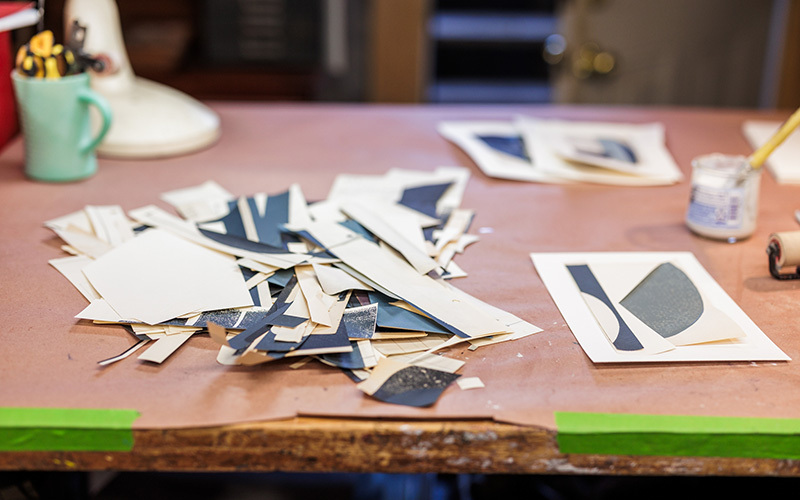 Sarah makes sure to keep plenty of cuttings around to be used in her collages.
Sarah makes sure to keep plenty of cuttings around to be used in her collages.
I'm annoyed with several of these new pieces. They don't look as good as they did when I made them, some of them weeks ago. Should I revise them or let them be? I don't have to seal them today, but that means I'll have fewer pieces for the Colorado show. I decide that two pieces really do need revisions.
It feels like I've accomplished nothing today and I'm feeling discouraged instead of proud of having made all these new pieces.
Thursday: The Artist Hits the Road
Rhode Island isn’t a big state, and I’ll practically drive across it by the time the day is done.
I’m headed to a Providence gallery to drop off three pieces they’ll be showing for the next few months. The gallery has a solo show up for a local artist who mixes collage with painting and walls of art from other artists (that must be where my pieces will go).
I seem to always be working with a few different galleries and different shows at the same time, with artwork going out and coming back on several different timetables. Artwork Archive helps me keep track of what pieces I have available for sale and licensing, so that when a gallery reaches out to me, I can create a portfolio of available work in a few minutes. I don't worry about sending incorrect information because I keep my records up to date.
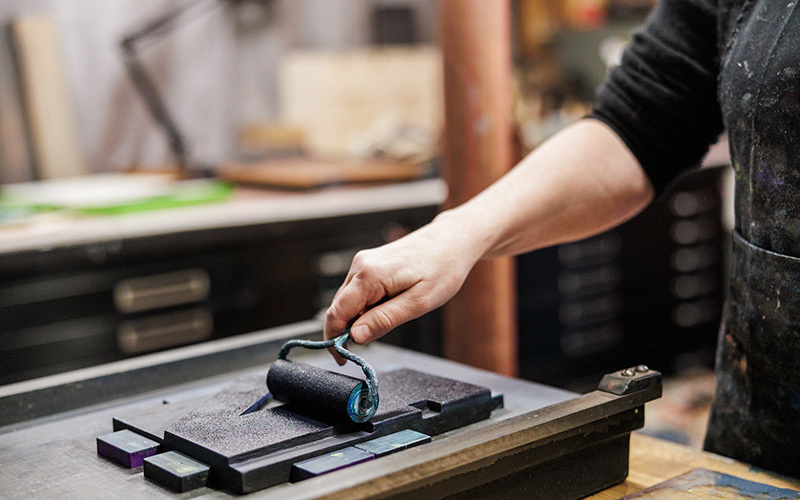 Inking up letterforms to create the blocky shapes that make up Sarah's work.
Inking up letterforms to create the blocky shapes that make up Sarah's work.
I've also gotten to be a pro at creating private rooms for gallery shows, so I can quickly share the link with my collectors—I try to make it as easy as possible for someone to support my work. And I’ve been lucky enough to get inquiries and sales about the pieces through Artwork Archive.
Today, I bring my Consignment Report I created with Artwork Archive to the gallery, and make sure that’s signed before I leave the pieces.
Friday: Prioritizing Creativity For the Future
My lunchtime reading is a New York Times article about the increasing number of people taking part in the No-Buy movement in anticipation of the new tariffs raising prices. How will this unstable financial environment affect my art business? Will people stop buying art? Will they skip taking art classes?
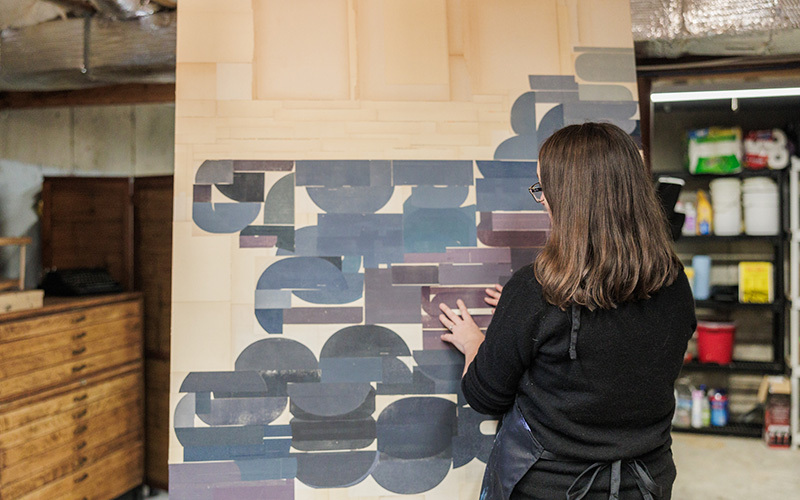 Sarah builds up each piece slowly, iteratively into a harmonious whole.
Sarah builds up each piece slowly, iteratively into a harmonious whole.
My art career has always focused on the people—the people who have encouraged and taught me, the people who take my classes, the people who have purchased my work and curated it in exhibitions.
At the start of every new year, I send a small gift to those who purchased a piece from me. I use the contacts and sales records in Artwork Archive to quickly create a list of who is receiving a gift. When I'm sending postcards for a show opening, the mailing labels are generated from my contacts. It takes only a few minutes to find the information I need in Artwork Archive. Besides the joy these human touches bring me, hopefully they’ll keep people invested in my artistic world in this tumultuous world.
Back in the living room, I find a new piece I'd forgotten about. Now I need to photograph this one and list it on Artwork Archive…
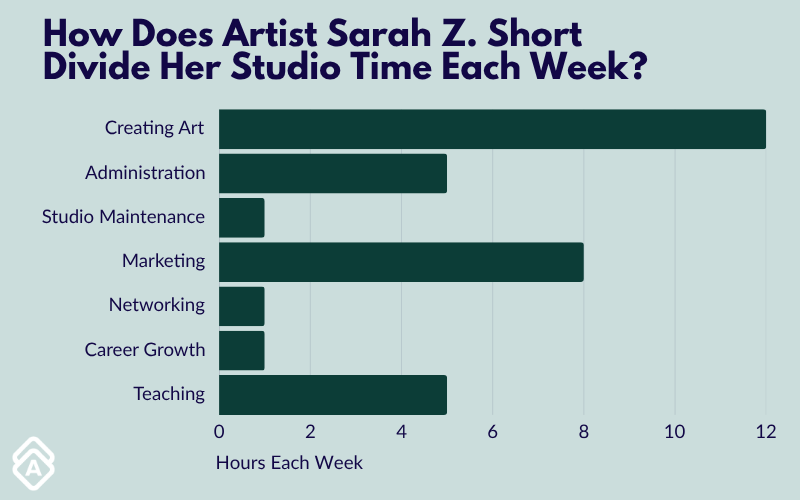
Every Art Business Could Use a Helping Hand—See How Artwork Archive Can Fit Into Your Work Week.
Sarah's week is busy, but she always finds time for both creativity and the administrative tasks that support it. She uses Artwork Archive because it's simple: it brings all of her art business tasks together in one place, so that she can easily track expenses and income, piece locations, upcoming deadlines, and more.
Because at the end of the week, she knows that if she doesn't spend at least a little time on things like reaching out to galleries, documenting her artwork, and corresponding with collectors, she won't be able to spend the rest of her time doing the thing she loves most of all: making artwork. See how Artwork Archive could be your digital studio assistant with a 14-day free trial.
